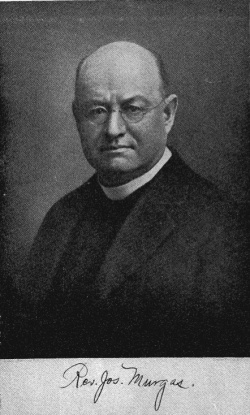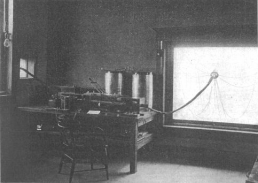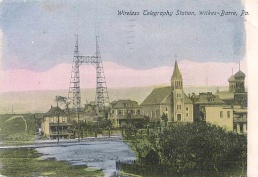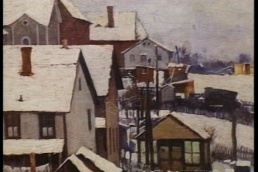Difference between revisions of "Jozef Murgaš"
| (4 intermediate revisions by the same user not shown) | |||
| Line 7: | Line 7: | ||
|death_place = Wilkes-Barre, Pennsylvania, United States | |death_place = Wilkes-Barre, Pennsylvania, United States | ||
}} | }} | ||
| − | ''' | + | '''Jozef Murgaš''' (EN: Joseph Murgas, 1864-1929) was a Slovak inventor, painter, architect, botanist, patriot, and Roman Catholic priest. He contributed to wireless telegraphy and helped to develop mobile communications and wireless transmission of information and voice. Murgaš was nicknamed the ''Radio Priest'' and deemed a Renaissance man. |
==Early life== | ==Early life== | ||
| − | Murgaš was born in Tajov (Tajó), Kingdom of Hungary, Austrian Empire (today Slovakia). Parents: Ján Murgaš and Zuzana (born Slamová). Since his youth he was bright, skillful and good at painting and electrotechnology. He attended grammar school in Tajov and high school in [[Banská Bystrica]] (1876–80), attending there the painting studio of [[Jozef Božetech Klemens]] who noticed his talent and also introduced him to | + | Murgaš was born in Tajov (Tajó), Kingdom of Hungary, Austrian Empire (today Slovakia). Parents: Ján Murgaš and Zuzana (born Slamová). Since his youth he was bright, skillful and good at painting and electrotechnology. He attended grammar school in Tajov and high school in [[Banská Bystrica]] (1876–80), attending there the painting studio of [[Jozef Božetech Klemens]] who noticed his talent and also introduced him to Dominik Skutecký. His parents were unable to further finance his studies leaving him with the choice of becoming a priest. He studied theology in Prešporok (today Bratislava) (1880–82) and Esztergom (1882–84). The vice-head of the school in Esztergom allowed him to use the physics room for experiments where Murgaš first comes in contact with tools for demonstrating electrical phenomena. |
==Studies in Budapest and Munich (1889-93)== | ==Studies in Budapest and Munich (1889-93)== | ||
| Line 114: | Line 114: | ||
==Links== | ==Links== | ||
* [http://www.stm-ke.sk/index.php/en/expositions/telecommunication-engineering Slovak Technical Museum: Telecommunication Engineering] | * [http://www.stm-ke.sk/index.php/en/expositions/telecommunication-engineering Slovak Technical Museum: Telecommunication Engineering] | ||
| − | * [http://www.indprop.gov.sk/swift_data/source/pdf/casopis_dusevne_vlastnictvo/DV_1203 Jozef Murgaš – Komunikácia včera a dnes], traveling exhibition, Slovakia, 2012. [http://www.svkbb.eu/aktualne-informacie/archiv-podujati/791-vystava-jozef-murga-komunikacia-vera-a-dnes] | + | * [http://www.indprop.gov.sk/swift_data/source/pdf/casopis_dusevne_vlastnictvo/DV_1203#page=37 Jozef Murgaš – Komunikácia včera a dnes], traveling exhibition, Slovakia, 2012. [http://www.svkbb.eu/aktualne-informacie/archiv-podujati/791-vystava-jozef-murga-komunikacia-vera-a-dnes] |
| + | * [http://www.stm-ke.sk/index.php/sk/vlastne-vystavy/414-vystava-murgas Jozef Murgaš - priekopník rádiotelegrafie], traveling exhibition, Paris and Bratislava, 2014-2015. | ||
| + | * [http://www.priekopnik.sk/priekopnik-radiotelegrafie-jozef-murgas-odhalenie-modelu-antenoveho-systemu-v-tajove/ Murgašov anténový systém], model, Tajov, unveiled 2015. | ||
* [http://www.cesa-project.eu/en/lexicon/authors/jozef-murgas Murgaš at Central European Science Adventure] | * [http://www.cesa-project.eu/en/lexicon/authors/jozef-murgas Murgaš at Central European Science Adventure] | ||
* [http://murgasarc.org/ Murgas Amateur Radio Club, Wilkes-Barre, PA] | * [http://murgasarc.org/ Murgas Amateur Radio Club, Wilkes-Barre, PA] | ||
* [http://explorepahistory.com/hmarker.php?markerId=1-A-3A1 Explore PA History: Rev. Joseph Murgas] | * [http://explorepahistory.com/hmarker.php?markerId=1-A-3A1 Explore PA History: Rev. Joseph Murgas] | ||
| − | * [http://en.wikipedia.org/wiki/Jozef_Murga%C5%A1 | + | * [http://en.wikipedia.org/wiki/Jozef_Murga%C5%A1 Wikipedia] |
| − | {{featured article}} | + | {{featured article}} {{DEFAULTSORT:Murgas, Jozef}} |
| − | {{DEFAULTSORT:Murgas, Jozef}} | ||
Revision as of 13:43, 30 July 2018
 | |
| Born |
February 17, 1864 Tajov-Jabríková (Tajó), Kingdom of Hungary, Austrian Empire |
|---|---|
| Died |
May 11, 1929 (aged 65) Wilkes-Barre, Pennsylvania, United States |
Jozef Murgaš (EN: Joseph Murgas, 1864-1929) was a Slovak inventor, painter, architect, botanist, patriot, and Roman Catholic priest. He contributed to wireless telegraphy and helped to develop mobile communications and wireless transmission of information and voice. Murgaš was nicknamed the Radio Priest and deemed a Renaissance man.
Contents
Early life
Murgaš was born in Tajov (Tajó), Kingdom of Hungary, Austrian Empire (today Slovakia). Parents: Ján Murgaš and Zuzana (born Slamová). Since his youth he was bright, skillful and good at painting and electrotechnology. He attended grammar school in Tajov and high school in Banská Bystrica (1876–80), attending there the painting studio of Jozef Božetech Klemens who noticed his talent and also introduced him to Dominik Skutecký. His parents were unable to further finance his studies leaving him with the choice of becoming a priest. He studied theology in Prešporok (today Bratislava) (1880–82) and Esztergom (1882–84). The vice-head of the school in Esztergom allowed him to use the physics room for experiments where Murgaš first comes in contact with tools for demonstrating electrical phenomena.
Studies in Budapest and Munich (1889-93)
After priestly ordination in 1888 in Banská Bystrica, Murgaš worked as a curate in Dubová. On Skutecký's initiative, Murgaš was accepted at a painting school in Budapest, where he studied from 1889–90. He also studied painting in Munich from 1890-93. He attended both schools while working. He painted sacral pieces, landscapes and personalities.
Religious service (1893-96)
It was due to his strong patriotism he exhibited during his visit of the bishop during holidays in 1893 (including his critical review of Munkacsy's painting Honfogalas) that he was not allowed to finish his painting studies and had to work as a curate at changing locations in the Kingdom of Hungary: Chrenovec (Nyitratormás), Slovenská Ľupča (Zólyomlipcse), Dubová (Cseres) and Lopej (Lopér). He created a sacral painting at each of these churches. In Lopej, he painted a large sacral picture of St. George, which is still on the church altar of the village. The central altar painting of St. Elisabeth, in the 14th century Church of St. Elizabeth in the main square of Banská Bystrica, is also his work.
Wireless telegraphy and radio experiments in the United States (1896-1920)

Due to permanent conflicts with the bishop's secretary and being accused of "panslavism", Murgaš replied to the call for a priest for a Slovak parish in newly founded mining city of Wilkes-Barre, Pennsylvania, counting 65 Slovak families. Murgaš emigrated in April 1896. Having no possibility to paint, besides his numerous communal activities in 1898 he started to deal with natural sciences again, especially electrotechnology. His article "Telegrafovanie bez drôtu" in Tovaryšstvo magazine of 1900 (his only article published in Slovakia) shows that his radiotelegraphy studies had achieved a high level, "Nič neni snáď čudnejsieho a tajomstva plnšieho medzi vynálezmi v odbore elektrickom jako telegrafovanie bez drôtu. Práve preto myslím, že nebude od veci napísať krátke vysvetlenie vážneho tohto vynálezu, nakoľko som to vstave učiniť a nakoľko som sa o tom vlastnými experimentami presvedčil."
- Murgaš' first two patents in wireless telegraphy
After Heinrich Hertz (1888) satisfactory demonstrated the existence of electromagnetic waves earlier theorised by Maxwell, Nikola Tesla demonstrated electromagnetic wave transmission on his lecture tour in Europe and the States (1890s), and Alexander Stepanovič Popov demonstrated wireless signal transmission over a distance of 250 m (1895, 5 km in 1897, 46 km in 1899), Guglielmo Marconi registered a patent for wireless telegraphy in England in 1896 based upon Popov's device and started a company for wireless telegraphy (in 1902 achieving radio connection across the Atlantic). Murgaš was aware of the importance of these developments and started working on their improvements. Unlike Marconi who used two different signal durations for dot and dash, his "musical wireless telegraph system" worked with two different signal frequencies of the same duration, making transmission 5-10 times faster.[2] On 2nd October 1903 he declared his first patent in Washington and on 10th May 1904, received the rights for two key patents by the Patent Office in Washington: the Wireless-Telegraph Apparatus (adaptation of a Wahnelt type interrupter and construction of an electromagnetic waves detector, in which a rotating carbon lug replaces a coherer with metallic swarf) and Method of Communicating Intelligence by Wireless Telegraphy (tone system for the transmission of Morse code signs, substituting the "dot" with a higher tone and the "dash" with a lower tone).[3]
- Public test of 'musical wireless telegraph system'
Following the first two patents, he created the Universal Aether Telegraph Co. based in Philadelphia. The Electric Signal Company was an investor. He established a laboratory in Wilkes-Barre to primarily investigate radiotelegraphy, and erected a 60-metre high antenna mast.[4] In early August 1905 Murgaš conducted successful test between Wilkes-Barre and Scranton, Pennsylvania, over a distance of 20 miles (30 km) in presence of company representatives (Stokes, Muckley), electrical expert (E. W. Stevenson), and expert telegraphers. The first message sent was "Thank God for His blessings."[5] His lab was visited by President Theodore Roosevelt on c10 August 1905 (after holding speech at Father Matthew Society in Scranton, PA) who was given a special demonstration of the system. It was the first time Roosevelt witnessed such a phenomenon, Murgaš was highly complimented and encouraged with a promise of government support.[6] Universal Aether Telegraph organized a public test of Murgaš' transmitting and receiving facilities on 23 November 1905, achieving radio transmission between Wilkes-Barre and Scranton having their mayors Frederick Kirkendall and Alexander Connell talk to each other at the rate of 45-50 words per minute (Marconi's system was capable of 15 WPM). Other participants included Samuel S. Robinson, representative of Secretary of the Navy Bonapart (at the suggestion of President Roosevelt); Arthur W. Goodspeed, physicist and electrical engineer; E. W. Stevenson, chief of staff of Electrical World magazine; Ernest G. Smith, president of the Wilkes-Barre Publishing Company, and others. Telegraphs were operated by Gideon W. Shadle in Wilkes-Barre and Thomas Murphy in Scranton; messages in English, Latin, Slovak and Polish were transmitted. Wilkes-Barre even received a confirmation receipt about successful connection to Brooklyn, 200 km away.[7]
- Two-way radio test
After experimenting with wireless transmission of voice for at least two years, in 1907 Murgaš organised private radio test. Kirkendall of Wilkes-Barre and Connell of Scranton again participated in wireless conversation, this time using their voice.[8]
However two months later a storm destroyed the antenna towers in Scranton and heavily damaged the ones in Wilkes-Barre. Before that, president and two directors of the company died. The original hope that the United States Navy would adopt Murgaš' tone system and thus award the company large contracts anticipated by the syndicate, did not materialize, which led to investment halt for Murgaš.[9]
One of his acquaintances in Wilkes-Barre, John Stenger as a young man at the time, experimented with electrical energy and later worked on the amplification of Murgas' invention. Stenger subsequently fabricated a sending and receiving radio station antedating that of KDKA owned by the Westinghouse company reputed to have been the first broadcasting station in America. In 1922 Stenger became owner of Station WBAX which still broadcasts today on 1210 in Wilkes-Barre.[10][1]
Interior of transmission and receiving station, Wilkes-Barre, 1905.[11]
Receiving apparatus, 1905.[12]
Details of receiving-R-wave detector, taken to pieces. R1-wave detector, set up. D-cover, S-steel shaft, P-pulley, B-nut for clamping needle, N-needle, C-carbon, PL-support, coated with platinum. 1905.[13]
Towers in Wilkes-Barre, 1905.[14]
Towers in Wilkes-Barre, 1905.[15]
- Underground wireless telegraphy
In 1906 Murgaš held experiments with underground wireless telegraphy between antenas placed in two 50-foot (15 m) holes in the ground separated by 100 feet (30 m). Signals were transmitted only with great difficulty and although he was granted patent in July 1907, it was but an idea which he soon abandoned because he considered it unfeasible due to metallic absorption of electrical waves when projected into the earth.[16] Newspapers however made it a sensation.[17]
- Marconi
Thomas Edison paid remarkable attention to Murgaš' experiments and he is said to have informed Marconi of Murgaš' success. Marconi then visited his lab in November 1905, received an explanation of the apparatus from Murgaš, and developed his Tone System into what he called Sonorous-System.[18] Marconi last visited him in 1917, when, in failing health, Murgaš gave Marconi his patents and all the information he needed. Murgaš lacked funding and did not want his patents "to be lost to the human race."
- Other patents
Further 15 patents followed between 1907 and 1916, including a patent on wave meter (1907), electrical transformer (1907), magnetic waves generator (1908), wireless telegraphy (1909), magnetic waves detector (1909), generator of electrical oscillations (1911 and 1916), or spinning reel for fishing rod (1912).[19]
Communal activities in the US
Murgaš' primary concern in Wilkes-Barre, however, were the local Slovaks. He took care of Slovak immigrants, had a new church, library, cemetery, several schools, gymnasium and playgrounds built, all of which are still used today. In 1911, together with thirty-eight Slovak priests, he founded the Slovak Catholic Federation [2]. He was also one of the founders of the Saints Cyril and Methodius community and took care of children and youth. He founded a cultural and religious weekly Katolík, and with Jozef Joščák published an illustrated entertainment magazine Šašek. Murgaš was active in the Slovak expatriates movement, wrote articles for their press, was one of the founders of the Slovak League in America, actively supported the creation of the state of Czechoslovakia, organized a fund of American Slovaks for the creation of Czechoslovakia (1,000,000 USD). He was one of the signatories of the Pittsburgh Agreement (1918) between Czechs and Slovaks on establishing Czechoslovakia [3]. As a respected personality, he gained trust and support of the highest authorities in the USA for the establishment of Czechoslovakia.
Later life
When the United States entered World War I (1917), private radio telegraphy stations were banned, which put an end to Murgaš' pioneering work in this field. He continued to study physics and to do many experiments, and he also returned to painting. He financed his activities by selling his paintings. He also collected mushrooms, plants, minerals and insects. His butterfly collection comprised 9000 pieces from all over the world and along with his moth collection was donated to King's College.[4]
Murgaš promised Masaryk to visit newly founded Czechoslovakia, which he did in 1920 (Masaryk was too busy to receive him then). He wished to teach electrotechnology but was declined a permit from the Ministry of Education in Prague due to insufficient qualification (and proposed him instead to serve as bishop of Czechoslovak Church). He returned to Wilkes-Barre four months later. He was nominated to be a member of the Federal Radio Commission of the United States in 1925 which Murgaš declined due to health problems. He died in Wilkes-Barre after a heart attack four years later. He is buried at Sacred Heart Cemetery, Dallas, PA.[5]
Notes
- ↑ Murgas 1905
- ↑ 1904
- ↑ Murgas 1905
- ↑ 1905a
- ↑ 1905b
- ↑ Palickar 1950, p. 61
- ↑ Palickar 1950, pp. 65-77. Includes transcript of selected messages.
- ↑ Palickar 1950, pp. 87-90. Includes improvised transcript of the radio conversation.
- ↑ Palickar 1950, pp. 90-94
- ↑ Palickar 1950, p. 88
- ↑ 1905a
- ↑ 1905a
- ↑ Murgas 1905
- ↑ Murgas 1905
- ↑ 1905a
- ↑ Palickar 1950, pp. 81-83.
- ↑ 1906
- ↑ Palickar 1950, pp. 61-62
- ↑ Palickar 1950, pp. 81-85
Writings
- "Telegrafovanie bez drôtu", Tovaryšstvo 3 (1900), Ružomberok, p 247. (Slovak)
- "Von s farbou!", Americkoslovenské noviny, 2 January 1901 and 17 January 1901. (Slovak)
- Murgas, Joseph (8 December 1905). "The Murgas System of Wireless Telegraphy". Electrical Review: 849-852.
- "Slnce", Jednota, catholic calendar, Cleveland, 1911. (Slovak)
- New Yorkčan (pseud.), "Na pomoc Slovensku", Newyorský denník VII (1920), No 2121-2124. (Slovak)
- "Z mojich skúseností", Newyorský denník VII (1920), No 2124-2130. (Slovak)
- "Rev. Murgaš odpovedá Jehličkovi", Newyorský denník VII (1920), No 2131. (Slovak)
- "Reverend Jozef Murgaš - autobiografia", Newyorský denník XVI (1929), No 4749-4750. (Slovak)
- polemics, Newyorský denník VII (1920), No 2138-2140, 2144, 2148-2151, 2153-2155, 2157, 2159, 2168, 2172, 2174, 2178. (Slovak)
Literature
Monographs, brochures
- Palickar, Stephen J. (1950). Rev. Joseph Murgas: Priest-Scientist. His Musical Wireless Telegraphy and The First Radio. New York: Theodore G. Kojis. pp. 164. [6].
- Palickar, Stephen Joseph (1953). A pictorial biography of Rev. Joseph Murgas, pioneer inventor in the field of wireless telegraphy and radio. Wilkes-Barre, PA: Murgas Memoiral Foundation. pp. 83. [7]
- Voda, Juraj (1955). Jozef Murgaš: priekopník rádiotelegrafie. Martin: Osveta. pp. 120 (Slovak).
- Vranka, Jozef (2004). Z doliny prerástol hory: Jozef Murgaš: kňaz, maliar, vedec, vynálezca. Bratislava: Arimes. pp. 280 (Slovak). [8]
- Jozef Murgaš - komunikácia včera a dnes. Bratislava: CVTI SR. 2014. pp. 30 (Slovak).
Articles
- F.R. Osvald, "Naši vzdelaní mužovia v cudzine", Literárne listy 8 (1898), pp 3-4. (Slovak)
- "Telegraphy by Music". The Saint Paul Globe: 31. 12 June 1904. Transcript.
- "The Murgas System of Wireless Telegraphy". Electrical World and Engineer: 100-101. 11 July 1905a.
- "Note about the Murgas Wireless System". Electrical World and Engineer: 212. 5 August 1905b.
- "Underground Wireless Telegraphy". Technical World: 326-327. May 1906a.
- "Životopis Jozefa Murgaša", Slovenské ľudové besedy II (1906), No 1, Ružomberok. (Slovak)
- "Rev. Jozef Murgaš a telefonovanie bez drôtu", Newyorský denník VII (1920), No 2064. (Slovak)
- Jozef Joščák, "Jozef Murgaš, ako som ho ja poznal", Newyorský denník XVI (1929), No 4759, 4764, 4770. (Slovak)
- Rudolf Štechmiler, Václav Hach, Průkopníci naší techniky, SNDK, Prague, 1945. (Czech)
- Janko Alexy, Osudy slovenských výtvarníkov, Bratislava, 1948. (Slovak)
- Václav Gutwirth, "Jozef Murgaš, zapomenutý slovenský vynálezce", Práce a vynálezy VII, 1948, No 4-5, Prague. (Czech)
- Václav Gutwirth, Z dětství naši elektrotechniky, SNTL, Prague, 1953. (Czech)
- Rudolf Štechmiler, "Aký bol Jozef Murgaš", Technické noviny II (1954), No 4, Bratislava.
- Rudolf Štechmiler, "Jozef Murgaš", Technické noviny (1954), Bratislava.
- Rudolf Štechmiler, "Jozef Murgaš", Věda a technika mládeži (1954), No 10, Prague.
- Rudolf Štechmiler, "Slovenský průkopník bezdrátové telegrafie", Amatérské rádio III (1954), No 7, Prague. (Czech)
- Rudolf Štechmiler, Živá minulost naší techniky, Mladá fronta, Prague, 1954. (Czech)
- Juraj Voda, "Jozef Murgaš - slovenský priekopník rádiotelegrafie", Naša veda I (1954), No 5, Bratislava. (Slovak)
- Ondřej Póss, "Jozef Murgaš", Pokroky matematiky, fyziky a astronomie, Vol. 25 (1980), No. 2, pp 61-65. (Slovak)
- J. Tibenský, et al, Priekopníci vedy a techniky na Slovensku 2, Bratislava, 1988, pp 791-798. (Slovak)
Theatre play
Links
- Slovak Technical Museum: Telecommunication Engineering
- Jozef Murgaš – Komunikácia včera a dnes, traveling exhibition, Slovakia, 2012. [10]
- Jozef Murgaš - priekopník rádiotelegrafie, traveling exhibition, Paris and Bratislava, 2014-2015.
- Murgašov anténový systém, model, Tajov, unveiled 2015.
- Murgaš at Central European Science Adventure
- Murgas Amateur Radio Club, Wilkes-Barre, PA
- Explore PA History: Rev. Joseph Murgas
- Wikipedia







